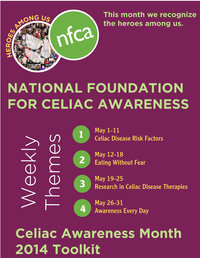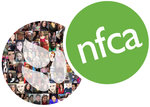Food Allergy and
Gluten-Free Awareness Apparel is Spotlighted in Publication’s “Allergy Shots”
Section; Messages Help Schools and Others be More Aware of Childrens’ Dietary
Concerns and Needs
SensitiviTees, “The sharing caring clothing company,” is a complete line of t-shirts for children and adults that alert others to the wearer’s food allergies or gluten-free diet. Readers of Allergic Living magazine are now aware of the line with its inclusion in the publication’s “Allergy Shots-Get in Gear” section in the fall 2014 issue, which came out in early September.
SensitiviTees, “The sharing caring clothing company,” is a complete line of t-shirts for children and adults that alert others to the wearer’s food allergies or gluten-free diet. Readers of Allergic Living magazine are now aware of the line with its inclusion in the publication’s “Allergy Shots-Get in Gear” section in the fall 2014 issue, which came out in early September.
The brand caught the attention of the magazine’s editor, Alisa Fleming, and the fall issue provided a timely spotlight as children with celiac disease or common food allergies head back to school, out of the careful watch of parents and caregivers. The SensitiviTees graphics tell others about the wearer’s food allergy or need to avoid gluten; designs include milk and dairy allergies, nut and peanut allergies, fish allergy, wheat allergy, and gluten-free designs.
The SensitiviTees brand has drawn the attention of food
allergy and celiac sufferers nationwide through its blog and website which
provide helpful information and resources for those communities. Last spring we
formed a strategic partnership with Brothers-All-Natural snacks, which caters
to individuals with various food allergies and sensitivities, including those
who maintain a gluten-free diet. In honor of Celiac Awareness Month in May,
SensitiviTees participated in an online contest sponsored by the snack company;
it is now participating in the Brothers-All-Natural Allergy-Friendly MegaGiveaway which will run through September 30, 2014.
CLICK ON THE IMAGE BELOW TO ENTER
THE MEGA ALLERGY-FRIENDLY CONTEST!!!
TO GET A WHOPPING 20% OFF ALL OF OUR INVENTORY
SIMPLY CLICK ON ANY OF THESE TEE SHIRTS BELOW.
AT CHECKOUT--ENTER THE PROMO CODE: GFE2014 FOR THE SAVINGS!





















 Back in April, NFCA asked the community to share their photos for our "secret project." We put them in our logo to show that you all are heroes within our community. The pictures were so great, we couldn't keep them to ourselves. Check out our
Back in April, NFCA asked the community to share their photos for our "secret project." We put them in our logo to show that you all are heroes within our community. The pictures were so great, we couldn't keep them to ourselves. Check out our 
 Celiac disease is a genetic autoimmune disorder triggered by the ingestion of gluten, a protein found in wheat, barley and rye. An estimated 1 in 133 Americans has celiac disease, yet 83% remain either undiagnosed or misdiagnosed. Currently, the only treatment is a strict, lifelong gluten-free diet.
Celiac disease is a genetic autoimmune disorder triggered by the ingestion of gluten, a protein found in wheat, barley and rye. An estimated 1 in 133 Americans has celiac disease, yet 83% remain either undiagnosed or misdiagnosed. Currently, the only treatment is a strict, lifelong gluten-free diet.






